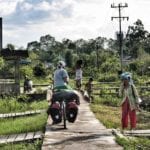Last Updated on 22 January 2025 by Cycloscope
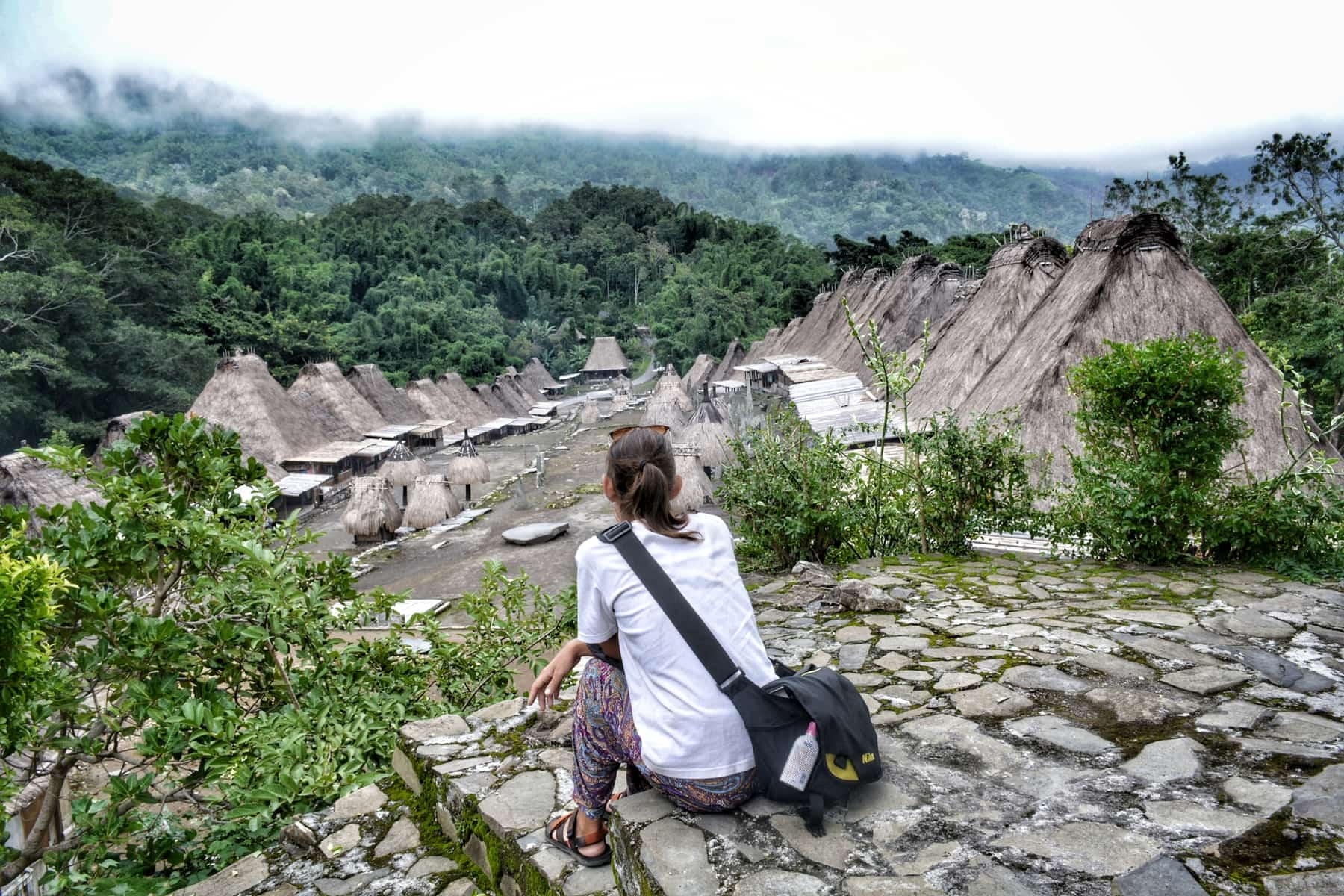
The traditional villages of Ngada region, Flores, Indonesia: Bena, Gurusina, and Wolondopo’s culture and rituals. What to see around Bajawa
Probably the most interesting place to visit in Flores Island, at least for the cultural aspects, Bena, Gurusina, and the other Nngada and Lio villages are timeless places, where the way of life is almost unchanged since centuries.
Set amidst the lush jungles and smoking volcanoes, Bena is said to have been founded some 1,000 years ago by Javanese sailors, whose ship was stranded on the south coasts of Flores.
Arriving here is like being teleported to another space and time, with women waving their Ikats on the carved wooden porches of the thatched houses, using traditional looms. An old man, his teeth black from the chewing of betel, is drying cocoa nuts on the moss-covered ground. A megalithic altar sits in the middle of the village, reverberating with a thousand years of chants and screams of sacrificial buffaloes.
Bena is about 13km from Bajawa, add a few more for Gurusina. Not far from Gurusina, there’s an almost secret spot not to be missed, the Malanage Hot Springs (GPS -8.883712, 121.003758 – Google knows). To get there, we advise you to rent a scooter in Bakawa (6€ per day). Hiring a guide is a good plus when visiting these villages.
If you’re interested in visiting this magical island, have a look at
The Perfect Flores Island Road Trip Itinerary
Advice for bicycle travelers and adventurers in Flores
and our in-depth articles about:
Maumere and Koka Beach, ghost horses on a white sand beach
Kelimutu Crater Lakes, the gate to another world
Forced religious syncretism – the Catholic Church and the traditional religions
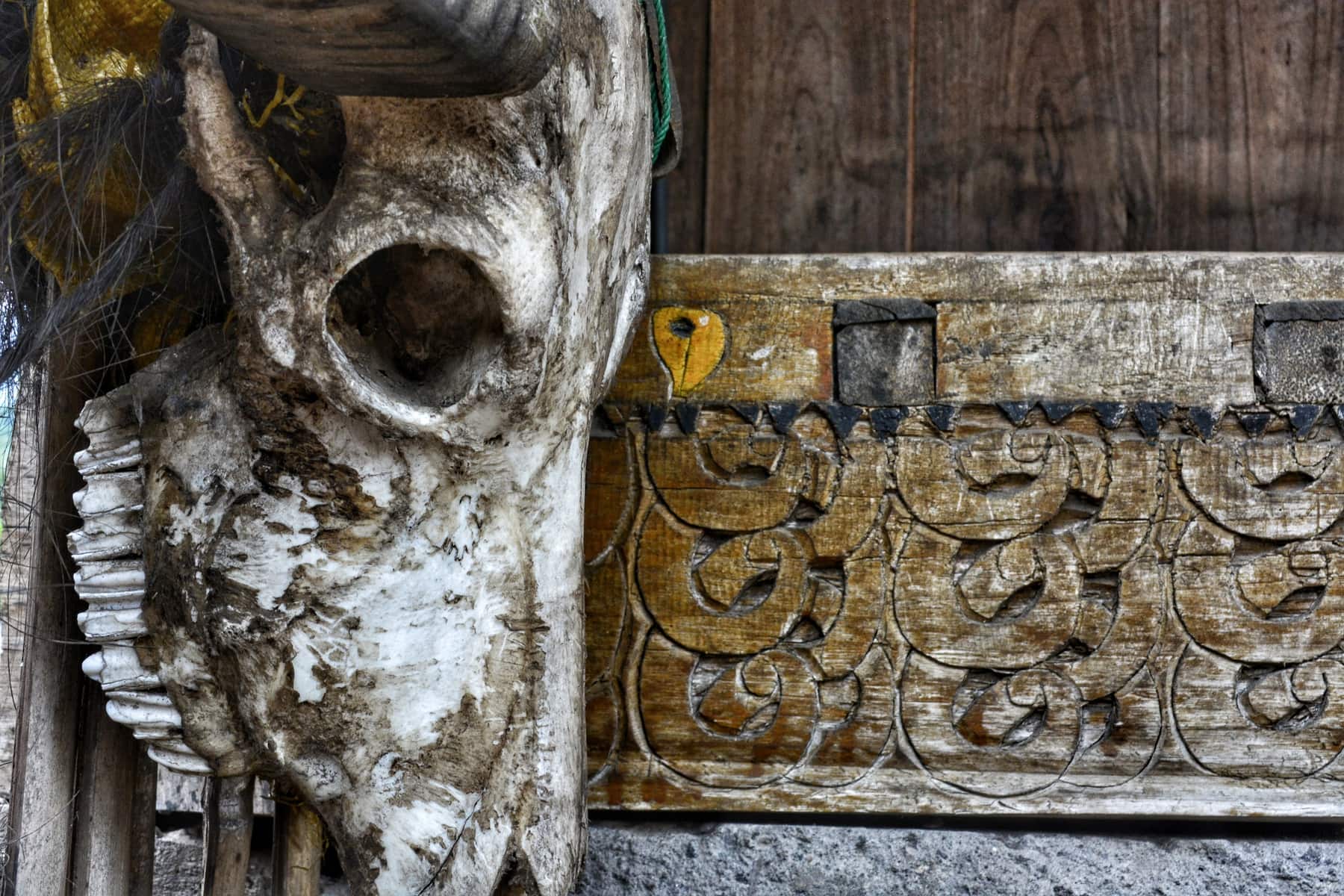
Indonesia is a universe, and each island is a planet. Thousands of different cultures, languages, and beliefs gathered under one flag. Despite this enormous diversity, the Indonesian government only recognizes six official religions: Islam, Protestantism, Catholicism, Hinduism, Buddhism, and Confucianism. There’s the seventh choice, and that’s atheism, a very dangerous choice since you’ll be marked as communist, and Indonesia doesn’t have a nice relationship with communists.
Religion in Indonesia has a dedicated field on the ID card, so each Indonesian citizen must choose one of the seven options. In Flores Island, as it happens also in Sumba and other Lesser Sunda Islands, the Catholic church takes advantage of the lack of government runt schools and hospitals, creating their own and opening them only to “the faithful”, forcing de-facto many people into conversion.
The Roman Church though is smart enough not to force people to completely abandon their rites, trying instead to blend them into the Roman rituals, as they did for centuries more or less everywhere, from Southern Italy to the Philippines.
Indeed Bena and the other ancestral villages in Flores still preserve their ancestral tradition; buffalo skulls and carved snakes beside the Christ on the cross is a common sight here.
The houses of Bena
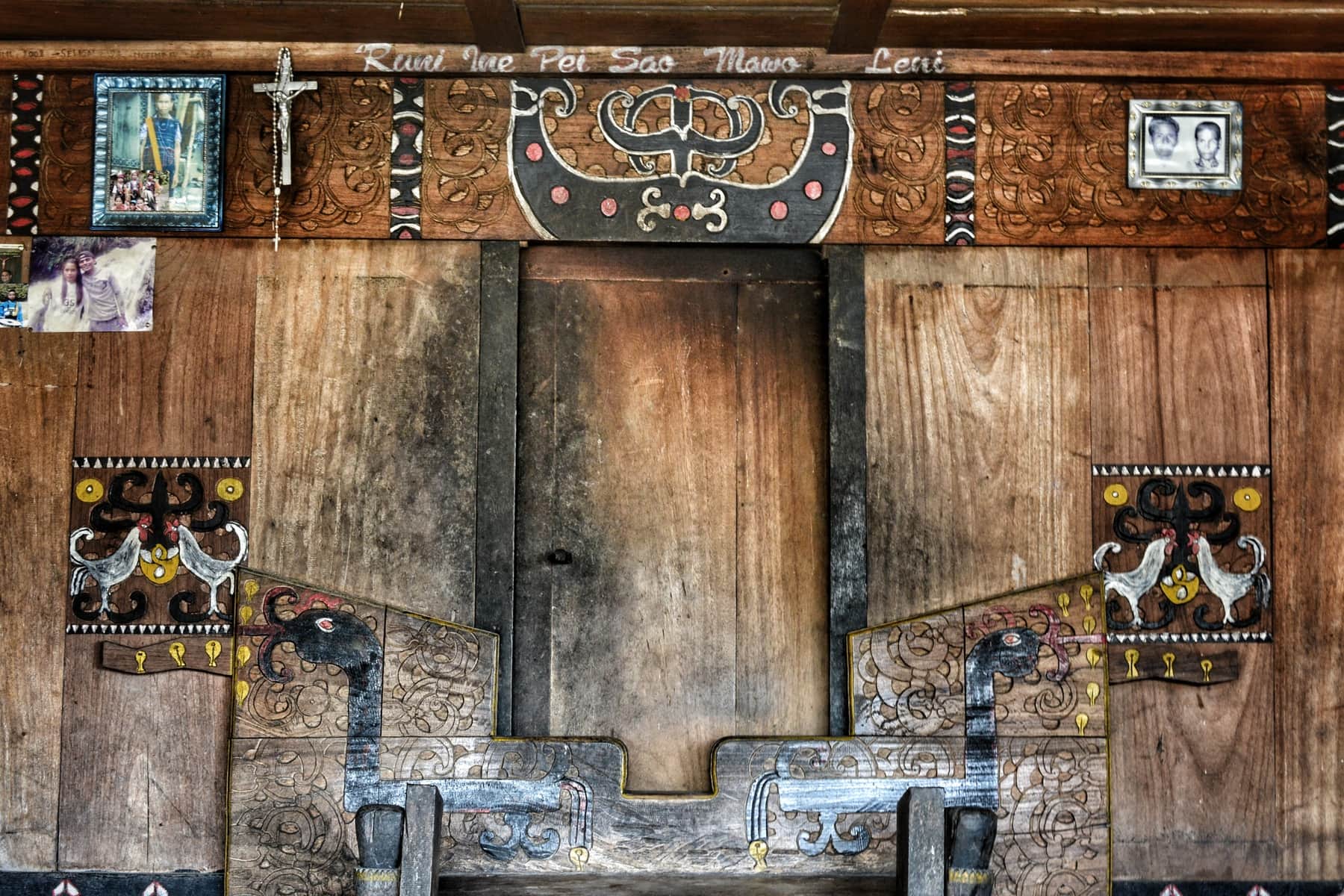
According to the elder’s stories, the village of Bena never moved from its original position, making it special among all the Ngada villages. There are nine clans in Bena, dwelling inside 45 houses. Each clan has a main house and one or more support houses.
Every element of the house is highly symbolic, nothing is meaningless here. They present very intricate carvings, Manu, the chicken, symbolizes the greatness of a person, as the animal can move to a higher place. A rooster is for daily life, as its sound wakes the people every day at dawn. A horse represents the strive to get a better harvest. The snake is the sacred creature protecting the house from the evil.
Male and female ancestors are present on the roof in the form of a hairpin inside a coconut for the female, and a statue wrapped in palm fibers, holding a machete and a spear, for the masculine aspect.
A tripartite cosmic idea is reflected in the construction of the houses, which have three structural levels (foundations, floor and walls, and ceiling), and a tripartite internal structure. The veranda (teda moa) for informal situations, is usually used by the women waving while looking after the children. The teda one, the first internal level, is for official situations, such as guest reception.
The inner part (one sao), is the spiritual center of the house, accessed from a small and short wooden ladder, its entrance is a small door, through which each person entering is forced to bow, as a sign of respect. Here the Mataraga altar is collocated, a medium to connect the gods with the earth. Here’s also the simple kitchen, made of stones, and a ngadhu (see below) to tie the animal waiting to be cooked.
Traditionally, all the materials are interlocked, without the use of any metal, although now the use of zinc roofs is diffused.
Structure of the Ngada society and rituals in Bena
Set at the lower east side of Mount Inerie, Bena is considered the oldest Ngada village. Candlenuts, cocoa, and clove are the main products on which the traditional economy relies. Today, Ikat weaving and tourism turned into an important source of revenue for the villagers. The Thursday Market in Jerebu’u, 3km south of Bena, is the place for the villagers to stock supplies. For more stuff, they depend on the Boubou market of Bajawa.
Although village administrative authority roles are officially applied, traditional authorities, elder people for each clan, are the ones that really matter in organizing the communities.
The houses are placed all around the wide yard (kisanatha) where the clan totems and the megalithic altar are placed. The male ancestors of each clan are represented by the Ngadhu, a wooden pole carved with ritual motifs, thatch, and palm fiber roofed with two hands holding a machete and a spear (just like on the houses). The Bhaga, a wooden box-shaped construction, that resembles the inner part of a house (one sao), represents the female ancestors. Each village has as many of these as the number of its clans.
The Reba ceremony
Every year, on the 27th of December, all the clans of Bena gather to discuss their problems and their future. The ceremony is also an expression of thankfulness to the gods for the year’s harvest, and a request for blessing for the next one.
This is the right time for a man to propose to a woman. The ritual takes three days: the initial day (laza rebha), when all the families gather at the main houses to discuss, dine, and drink. The cleansing day (batu ngaza), with mass prayers, dances, and chants, ends again with dinner. The third day with the sacrificial offering on the megalithic altar.
Traditional Ikat weaving
Ikat, or ikkat, is a dyeing technique used to pattern textiles that employs resist dyeing on the yarns prior to dyeing and weaving the fabric. It’s diffused all over Indonesia and Malaysia.
The various motives applied to the Ikat each have their own symbolic meaning. There are children’s motifs, representing the seeking of knowledge. Horse motives, waved if the ikat is used as a means of transportation. Ghi-u, arched curves resembling mountains, are a sign that humans must live dynamically. Ube, forming a spear, is a marker of self-protection against the enemy. If the motive is in a bigger size, it’s called gajah and can be worn only by higher social ranks, as a symbol of power.
Bhaga motives are a fertility symbol, worn by women with children. The peculiarity of Bena’s Ikat is the use of indigo as a base color, while in other Ngada villages, it’s usually white.
Bicycle Touring from Moni to Ende – 62km: The Lio village of Wolondopo
Our road trip, from Moni and Kelimutu to Bajawa by bicycle
After visiting the Kelimutu Crater Lakes and the Moni surroundings, we leave, again heading towards Labuan Bajo, along the main road. Another 10km uphill (reaching over 1,000msl), a short plateau between two valleys, and then begins the sweet descent. Landscapes are more and more amazing, terraced rice paddies, lush forests, and great waterfalls. We have to stop every five minutes to take a picture.
If you don’t go too fast, you may notice a small sign on the right-hand side of the street where the traditional village of Wolondopo is located, two kilometers away. A detour worth taking. The road is a steep climb, that reaches this amazing little village surrounded by jungle and coffee plantations.
The houses are made of bamboo, they do not have windows, they are completely open on the sides. Outside there is a common kitchen, where the villagers, in turn, cook for everyone. The inhabitants of this area are called Lio, and they are another one of the Flores ethnic groups.
People look at us astonished, we are aliens, I think here they rarely see a white man or a tourist in general, they must think we are lost. This beauty of bicycle touring in Flores (or everywhere else).
Ende
We continue the spectacular descent that, at a certain point, is blocked by a landslide. We stop to wait, at the side of the road there are food and drink vendors, this makes us worry about the waiting time. We wait an hour eating hard-boiled eggs and drinking coffee while the road is freed.
Back on the main road, we continue the descent, reaching the sea level in Ende, a typical Flores ugly town with a few ugly guesthouses.
We enter a restaurant to eat but the food is literally rotten. We run away looking for a restaurant run by Chinese people, and fortunately, we find it. Apart from a stone found in the dish, is all edible. In Flores, everything is nice except the food.
Road trip from Ende to Bajawa – 124 km
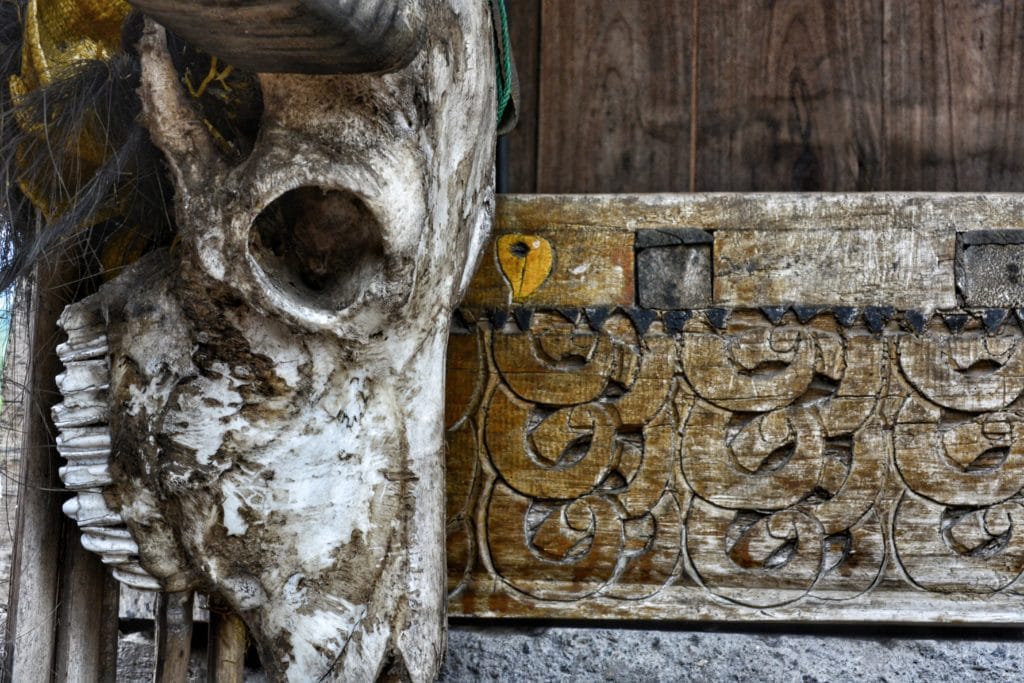
After a night in the city, we set off again towards Bajawa which, of course, is 1200 meters high. In Flores there is no escape, you climb to 1200, you go back to the sea, you go back to 1200 and you go back to the sea, and so on.
Cycling east, for the first 40km, the road is a beautiful coastal roller coaster. Black volcanic sand beaches are great to cool down, we met wavy water though. Then the climb to Bajawa begins, we stop at a bamboo restaurant run by wife and husband, it starts to rain badly and so they tell us that we can sleep there. We mount the tent to protect ourselves from mosquitoes.
Today we face the real ascent, long and steady, 80km up to 1,400msl. It’s not as steep as the one to Moni but its length makes it exhausting. As usual on this road trip in Flores Island, jaw-dropping views are plentiful, with incredible rice terraces that make those of Bali pale in comparison. At about 1,000msl the vegetation changes completely, turning from tropical jungle to almost alpine forest. It gets chilly also.
Even along this road, there are not many options for food and no accommodation. Pack supplies and be ready to pitch your tent if you can’t make it up there, although it won’t be easy to find a camping spot.
After a quite devastating day, somehow we make it and in the evening we arrive in Bajawa where Daniele is happy to eat the Sape Babi, pork skewers with peanut sauce.
Bajawa, the Nngada villages, and Malanage hot springs
Bajawa itself is a moderately big town for Flores standards, with plenty of accommodations available, good food options, and a nice market.
Bena is about 13km from Bajawa, add a few more for Gurusina. Traveling by bicycle to these villages though is very hard and time-consuming. Although the road is paved, the gradients are extreme for bicycle touring. So again we rent a scooter for the price of 6€ per day.
Not far from Gurusina there’s an almost secret spot not to be missed, the Malanage Hot Springs (GPS -8.883712, 121.003758 – Google knows). Here an extremely hot spring flows into a cold river, bathing in this is just the perfect ending to a day, just moving around in the water the temperatures change, allowing for you to find your favorite temperature.
If you’re interested in visiting this magical island, have a look at
The perfect Flores Island Road Trip Itinerary
Advice for bicycle travelers and adventurers in Flores
and our in-depth articles about:
Maumere and Koka Beach, ghost horses on a white sand beach
Kelimutu Crater Lakes, the gate to another world
The route map of our road trip in Flores, click the track for elevation data
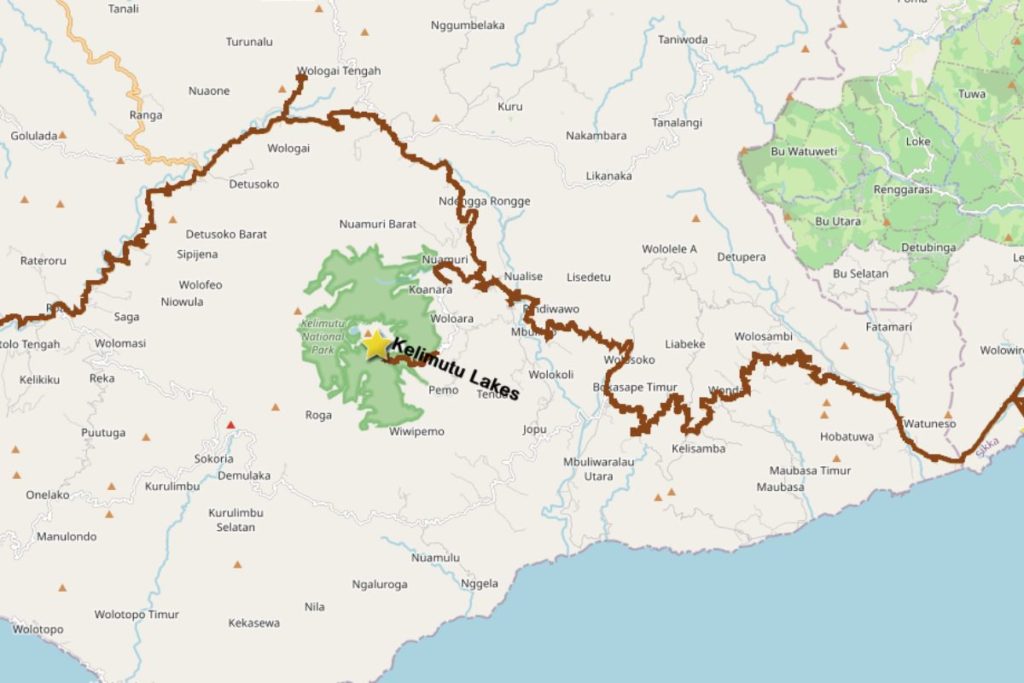
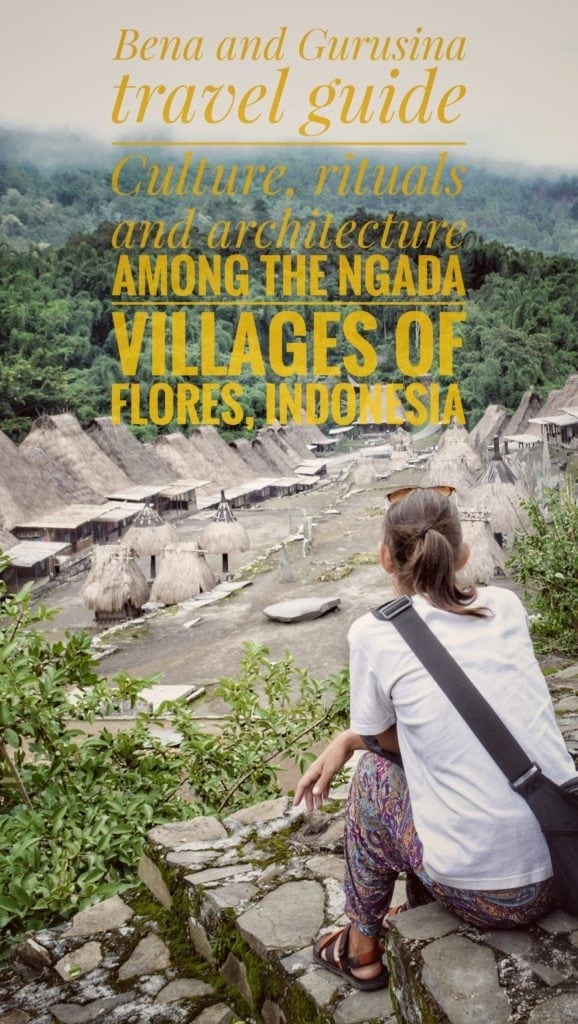
Follow us while we get lost


